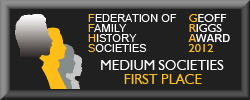|
|
CommentsGone but not forgotten
published by Jenny Towey - 22 days ago. | | Thank, you, Rob, for all your dedication and hard work to produce our new, good-looking and informative website. Jenny | |
June 2025 Newsletter
published by Jenny Towey - 1 months 1 day ago. | | Thanks so much for the "run-down" of the new website, Rob - I'm sure everyone will be really impressed with it. My dad was stationed in Malta in about 1950. My mum and I joined him. She enjoyed living there. Hope to see many of you at our Wednesday meeting, June 11th - as Pat has mentioned there is a change of speaker and subject: me and husband Peter on How to use The National Archives. | |
Cox
published by Kathy Viney - 1 months 24 days ago. | | | Hi there - new member here!My GGgrandmother was Mary Sayer Cox, born in Yatton in 1834. She emigrated to Australia and married my GGgrandfather Henry Goulstone of Long Ashton there. They eventually moved to New Zealand and founded the Goulstone family here.Mary's father was James Fitchew Cox and his first wife, Mary Ann White. Mary died not long after giving birth to their second child, who also died young. When James remarried and moved to Barbados, Mary was left in the UK lodging. (How I would love to know if she knew her future husband before leaving for Australia!)James Fitchew Cox's father, Stephen Cox, was a tanner. His business was called Messrs. Cox & Co or Stillhouse Lane. I bet he was a popular guy in town, creating all that pollution and awful smells!I hope this helps link my ancestors with other Coxes from the area. I would love to hear from you! | |
Cox
published by Kathy Viney - 1 months 24 days ago. | | | My GGgrandmother was Mary Sayer Cox, born in Yatton in 1834. She emigrated to Australia and married my GGgrandfather Henry Goulstone of Long Ashton there. They eventually moved to New Zealand and founded the Goulstone family here.Mary's father was James Fitchew Cox and his first wife, Mary Ann White. Mary died not long after giving birth to their second child, who also died young. When James remarried and moved to Barbados, Mary was left in the UK lodging. (How I would love to know if she knew her future husband before leaving for Australia!)James Fitchew Cox's father, Stephen Cox, was a tanner. His business was called Messrs. Cox & Co or Stillhouse Lane. I bet he was a popular guy in town, creating all that pollution and awful smells!I hope this helps link my ancestors with other Coxes from the area. I would love to hear from you! | |
Cox
published by Brian & Pam Airey - 1 months 25 days ago. | | | I have just received information from a new member requesting details of Cox's from Yatton. The member is Kathy Viney and can be contacted on kathy.viney@gmail.com | |
GOULSTONE
published by Kathy Viney - 1 months 25 days ago. | | | I have written up what I know of Dollie on her WikiTree profile here: https://www.wikitree.com/wiki/Marusajian-1Please let me know if you think there are errors!:-) | |
|
Forthcoming Events
|
|
| Library Help Session
Saturday, 5th July, 2025 14:00 - 15:30 | | Physical Members' Meeting
Wednesday, 9th July, 2025 14:30 - 17:00 | | Library Help Session
Monday, 14th July, 2025 10:30 - 13:00 | | Workshop by Zoom: In the footsteps of Hans Fowler Price
Wednesday, 23rd July, 2025 19:30 - 20:30 | | Library Help Session
Monday, 18th August, 2025 10:30 - 13:00 | | <- View calendar for more |
|
|
|
